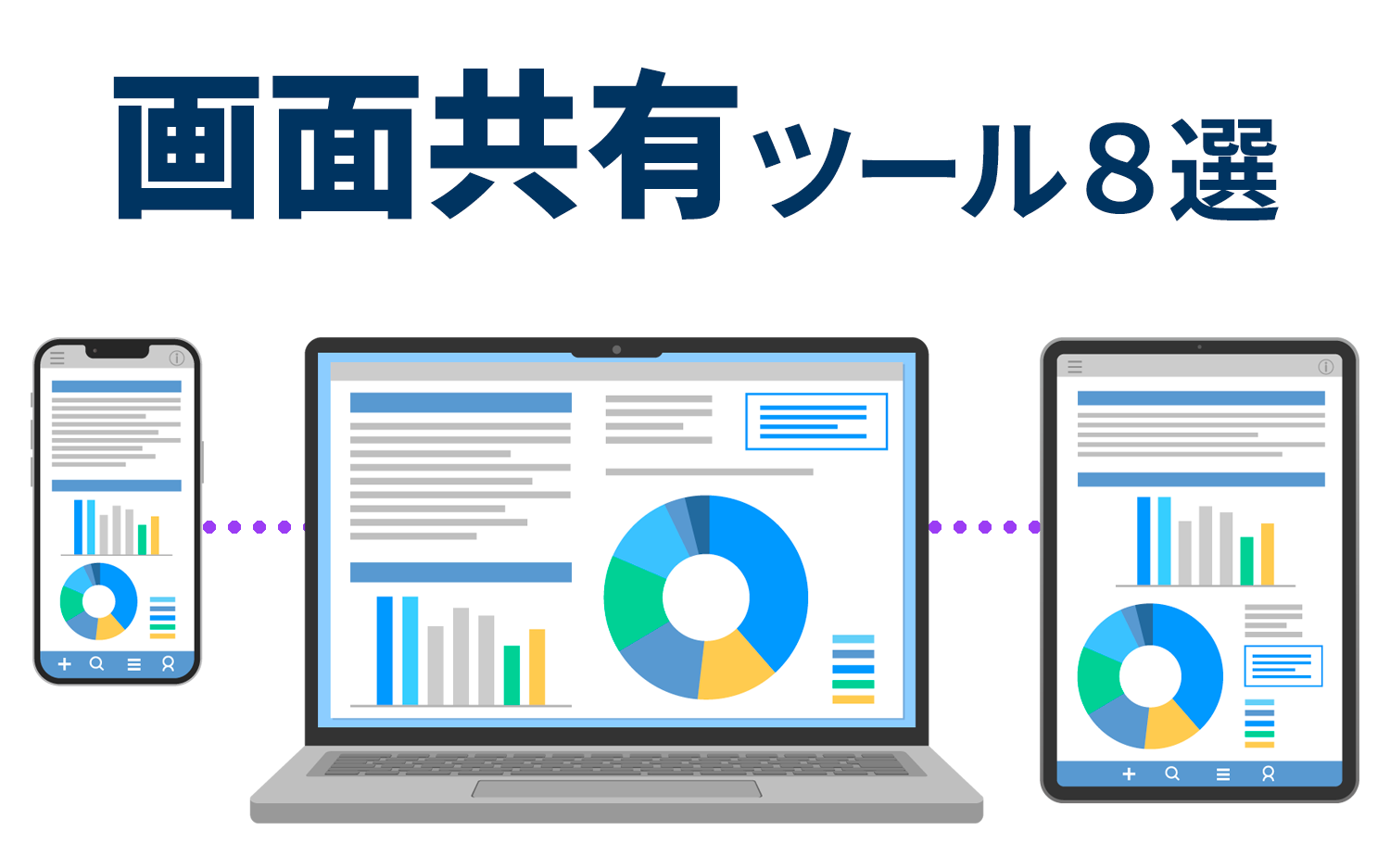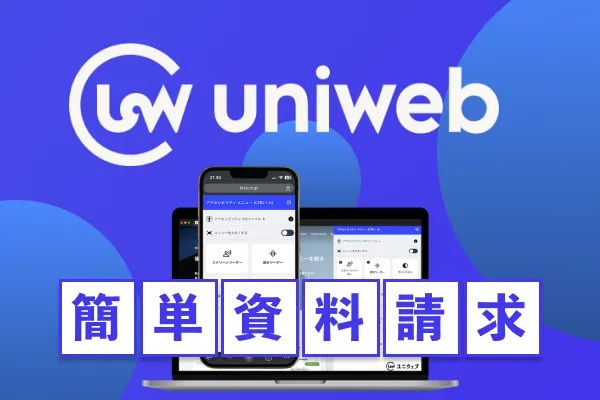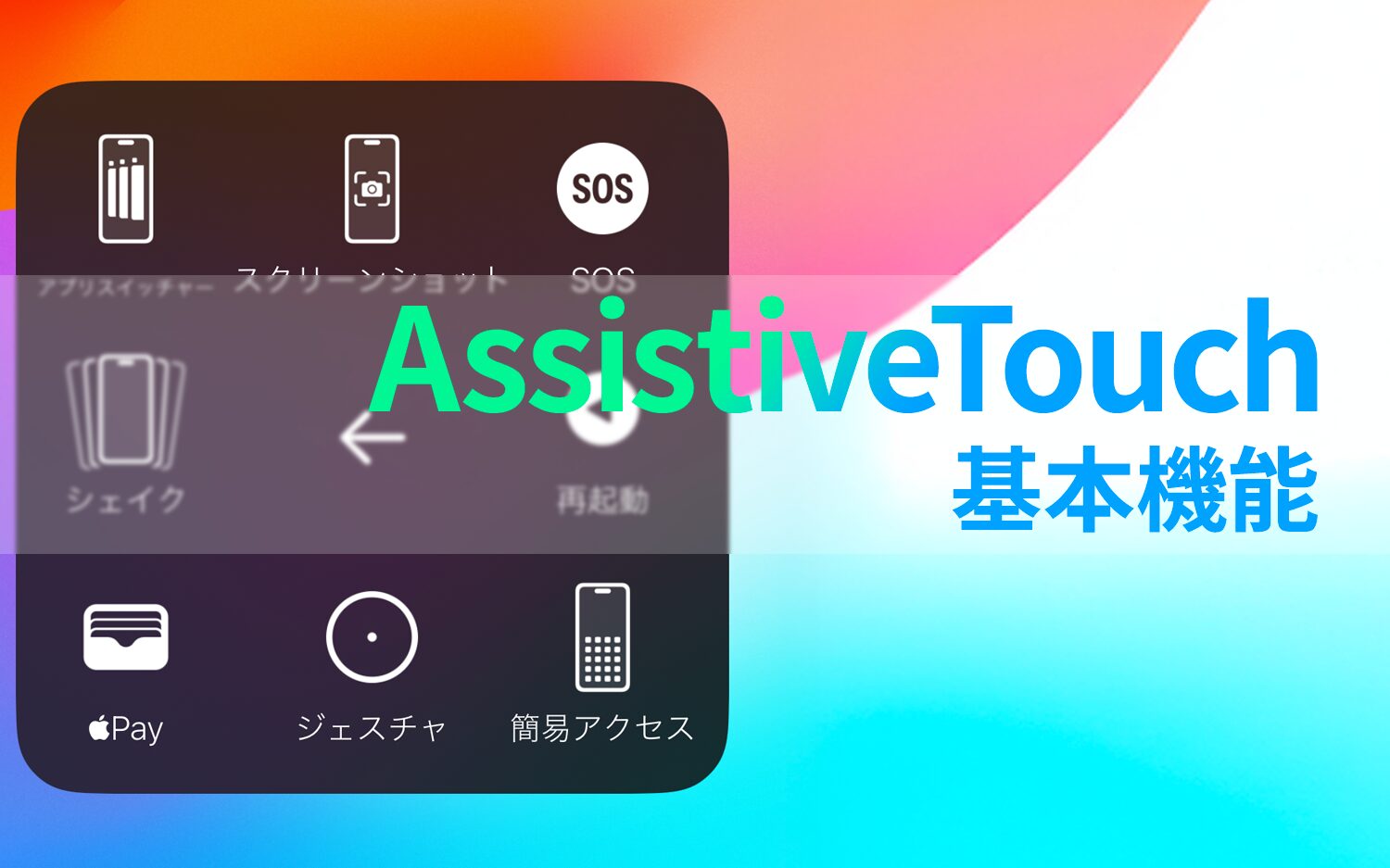Eight "screen sharing tools" for novice users to choose from.
2024/12/26

Screen SharingScreen sharing is a function that allows you to share your PC or device's screen with other participants in real-time during online meetings or remote support. In 2020, due to the COVID-19 pandemic, the use of screen sharing tools rapidly expanded as stay-at-home orders and remote work increased. These tools are utilized in various scenarios, including online meetings, classes, remote support, presentations, and information sharing within teams.
Currently,ITincluding beginnersthere are eight representative screen sharing tools widely used by many users.
Tool 2: Google Meet
Tool 3: Microsoft Teams
Tool 4: Skype
Tool 5: Webex by Cisco
Tool 6: TeamViewer
Tool 7: Chrome Remote Desktop
Tool 8: UniWeb's Cobrwosing
These tools offer free plansand many can be easily used by anyone. They cater to various applications including online meetings, remote support, and large-scale events.
In particular,for screen sharing that requires security, such as those containing personal informationit is recommended to use high-function screen sharing tools that can mask highly confidential information,like UniWeb's Cobrwosing feature.
In this article, we will explain the characteristics and selection methods of the eight tools recommended for beginner users, as well as common troubles and their resolutions. If you are considering implementing screen sharing tools, please read until the end.
Table of Contents
Eight Easy-to-Use Screen Sharing Tools for Beginners (With Free Plans)
There are many types of screen sharing tools, and it's not uncommon for people to be confused about which one to choose. Here, we will introducerepresentative screen sharing tools that are easy to use even for beginners and supported by many usersamong eight options.
| Tool Name | Features | Pricing Plan | Simultaneous Connections | Time Limit |
| 1. Zoom | - Mainly used for online meetings and seminars - Allows discussions and work in small groups during meetings - Includes annotation features |
- Basic: Free - Pro: ¥1,999/month (annual contract) - Business: ¥2,749/month (annual contract) |
- Basic/Pro: Up to 100 participants - Business: Up to 300 participants |
- Basic: 40 minutes - Business/Pro: 30 hours |
| 2. Google Meet | - Mainly used for short team meetings and educational purposes - Can be easily set up with Google Account integration - All features available on the browser - Phone participation is also possible |
- Free Account: Free - Business Starter: ¥680/month (annual contract) - Business Standard: ¥1,360/month (annual contract) - Business Plus: ¥2,040/month (annual contract) - Enterprise: Inquiry required |
- Free Account: Up to 100 participants - Business Starter: Up to 100 participants - Business Standard: Up to 150 participants - Business Plus: Up to 500 participants - Enterprise: Up to 1,000 participants |
- Free Account: 1 hour if more than 3 people, 24 hours for one-to-one - Business Starter: 24 hours - Business Standard: 24 hours - Business Plus: 24 hours - Enterprise: 24 hours |
| 3. Microsoft Teams | - Mainly used for teamwork and collaboration - Rich collaboration features - Can connect with Office applications |
- Microsoft Teams: Free - Microsoft 365 Personal: ¥1,490/month - Microsoft 365 Family: ¥2,100/month - Microsoft Teams Essentials: ¥599/month (annual contract) - Microsoft 365 Business Basic: ¥899/month (annual contract) - Microsoft 365 Business Standard: ¥1,874/month (annual contract) |
- Microsoft Teams: Up to 100 participants - Microsoft 365 Personal: Up to 300 participants - Microsoft 365 Family: Up to 300 participants - Microsoft Teams Essentials: Up to 300 participants - Microsoft 365 Business Basic: Up to 300 participants - Microsoft 365 Business Standard: Up to 300 participants |
- Microsoft Teams: 1 hour - Microsoft 365 Personal: 30 hours - Microsoft 365 Family: 30 hours - Microsoft Teams Essentials: 30 hours - Microsoft 365 Business Basic: 30 hours - Microsoft 365 Business Standard: 30 hours |
| 4. Skype | - Mainly used for personal use or small meetings - Can be used in the browser without sign-up or download - No expiration date for invitation links |
Free | Up to 100 participants | 24 hours |
| 5. Cisco Webex | - Mainly used for large events or meetings at corporations and organizations - Highly secure, rated top by U.S. National Security Agency - High-quality, wide-angle dedicated webcams are also available for sale |
- Webex Free: Free - Webex Starter: ¥1,490/month - Webex Business: ¥2,200/month - Webex Enterprise: Inquiry required |
- Webex Free: Up to 100 participants - Webex Starter: Up to 150 participants - Webex Business: Up to 200 participants - Webex Enterprise: Up to 1,000 participants |
- Webex Free: 40 minutes - Webex Starter: 24 hours ・Webex Business: 24 hours ・Webex Enterprise: 24 hours |
| ⑥ TeamViewer | ・Often used mainly for remote support and troubleshooting through remote desktop features. ・Can securely access remote devices without regard to time or location. ・Available on almost all devices, including PCs and smartphones. |
・Personal license: Free ・TeamViewer Remote Access: ¥3,425 per month (annual contract) ・TeamViewer Business: ¥6,000 per month (annual contract) ・TeamViewer Premium: ¥11,500 per month (annual contract) ・TeamViewer Corporate: ¥21,000 per month (annual contract) |
・Personal license: Unlimited ・TeamViewer Remote Access: Up to 3 devices ・TeamViewer Business: Up to 200 devices ・TeamViewer Premium: Up to 300 devices ・TeamViewer Corporate: Up to 500 devices |
・Personal license: 3 hours ・TeamViewer Remote Access: Unlimited ・TeamViewer Business: Unlimited ・TeamViewer Premium: Unlimited ・TeamViewer Corporate: Unlimited |
| ⑦ Chrome Remote Desktop | ・Mainly used for remote support and simple screen sharing. ・Remote access and screen sharing using the Google Chrome browser. ・Simple to operate and free, making it accessible for anyone. |
Free | 1 device | 24 hours |
| ⑧ Univeb 'Cobra Browsing' | ・Can provide security responses tailored to the site. ・Uses markers for visual guidance. ・Can be easily implemented by using just a one-line tag on the site. ・By using chat in conjunction, support can be more efficient. |
Inquiries required | Unlimited | Unlimited |
The tools listed in this table can be broadly divided into two categories.
・⑥〜⑧:Tools specialized in screen sharing
The tools from ① to ⑤ are,Multifunctional, necessary for meetings and collaboration.While equipped with features, their characteristic is to enable smooth screen sharing. Tools from ⑥ to ⑧ are specialized for screen sharing. These are designed to be easy to operate and lightweight, therefore,They are suitable for quick screen sharing and remote support.are ideal for.
Below, I will elaborate further on the features of each tool.
Tool 1: Zoom
Tools for online meetings and remote work
Zoom is a tool that is supported by many users for its simple operability and multifunctional screen sharing. In particular,The 'breakout room feature' that allows the division of participants into small groups during meetingsis ideal for use in educational settings and businesses.
In addition,Using the annotation feature, participants can directly add notes to the shared screen, enabling a more active exchange of opinions in meetings.The free plan also offers basic meeting functions, making it suitable for both personal and corporate use.
◆ Recommended for those who:
・Emphasize group discussions and learning activities.
Tool 2: Google Meet
Tools for online meetings and remote work
Google Meet is,Easy to start using with a Google account.This screen sharing tool offers the advantage of convenience. Since all features can be accessed directly in the browser, there is no need for additional app installation, making it suitable for educational environments and short team meetings. Moreover,The ability to participate via phone and the scalability to accommodate large meetings by integrating with Google Workspaceare among its features.
Along with Zoom, it is another tool used by many users, but for free use, Google Meet is convenient as it allows 24-hour one-on-one connections.
◆ Recommended for those who:
・Companies or individuals who regularly use Google Workspace.
Tool 3: Microsoft Teams
Tools for online meetings and remote work
Microsoft Teams is a tool rich in collaboration features to facilitate teamwork.Collaboration features.It is a tool equipped with. In particular,It excels in integration with Microsoft Office applications like Word and Excel, allowing documents to be co-edited in real-time.This is its strength.
Additionally, it allows for centralized management of project progress using task management and dedicated chat features within the team. The free plan includes basic functionalities, catering to a wide range of users from businesses to educational institutions.
◆ Recommended for those who:
・Companies or individuals using Microsoft 365.
Tool 4: Skype
Tools for online meetings and remote work
Skype is an attractive tool that can be used for free for up to 100 people 24 hours a day. In particular,No sign-up or app installation is required,which can be directly used from the browser is a feature.The invitation link has no expiration date,so you can easily join meetings at any time.
It also has voice call and chat features, making it suitable for personal use or small teams, as it accommodates various communication styles beyond just screen sharing.
◆ Recommended for those who:
・Beginners or non-technical individuals who want to use simple tools.
Tool 5: Cisco Webex
Tools for online meetings and remote work
Cisco Webex is an enterprise tool specialized for large meetings and events. Its greatest feature is thatthe high level of security, which has received the highest rating from the U.S. National Security Agency.This allows secure handling of very sensitive meetings.
Furthermore,The system has unique features, such as the 'gesture recognition' feature that recognizes the user's hand movements and displays animations on participants' screens, or the AI-driven 'automatic transcription' and 'real-time translation' features.These are also unique features that are not found elsewhere.
◆ Recommended for those who:
・Those who frequently host meetings or events with hundreds of participants.
Tool 6: TeamViewer
Tools specialized in screen sharing
TeamViewer is a tool equipped with remote desktop capabilities, allowing not just screen sharing but also direct control of remote devices. It enables safe remote support regardless of time or location, making it widely used for IT support and troubleshooting.
Supports various operating systems like Android, iOS, and Windows, ensuringthat it can be used on almost any device from PCs to smartphones.The free plan allows unlimited devices, butbecause it is primarily for non-commercial use, connections may be interrupted if commercial use is detected.。
◆ Recommended for those who:
・Individuals who want to securely operate remote devices.
Tool 7: Chrome Remote Desktop
Tools specialized in screen sharing
Chrome Remote Desktop is,using the Google Chrome browser,It is a completely free tool that allows easy remote access and screen sharing, similar to 'Google Meet'.you can start using it immediately with a Google account.。
With simple settings that do not require software installation or complex operations, it is characterized by its ease of use for beginners. It allows safe operation of remote PCs and smartphones, making it suitable for a wide range of applications from personal use to IT support.
◆ Recommended for those who:
・Those looking for simple remote tools that are user-friendly for beginners.
Tool 8: UniWeb's Cobrwosing
Tools specialized in screen sharing
The option feature 'Cobrowsing' provided by the web accessibility tool 'Uniweb' is a screen sharing tool that allows end-users to share the web page they are viewing in real-time while receiving assistance.It includes a security feature that automatically masks personal information and credit card details.This allows for safe use even in situations dealing with sensitive information.
With visual guidance showing the operation points marked and the use of chat functions, it ensures smooth support that is easy for end-users to understand.The ease of installation, requiring just a single line of code to be added to the website, is also a significant advantage.。
◆ Recommended for those who:
- Industries requiring high-security support for handling personal information
These are representative screen sharing tools. Each tool has its unique features and benefits, making it important to choose based on the use case and purpose. By selecting tools that match their characteristics, more efficient utilization is possible.
Next, let’s discuss the key points to keep in mind when choosing a screen sharing tool.
Five Points to Check When Choosing a Screen Sharing Tool
As mentioned in the previous section, there are various screen sharing tools, each with its own features and strengths. It is crucial to choose one based on several key points, such as whether it fits your purpose and usage scenarios, and how user-friendly it is.
Here, we will detail five key points to particularly check when selecting a screen sharing tool.
Point 1: Features that Match Your Purpose and Usage Scenario
First, it is important to clarify the purpose of using the screen sharing tool and choose one that has the appropriate features. For instance, breakout rooms (※) and annotation features of 'Zoom' are useful in online meetings and educational settings.
On the other hand, for remote support regarding customer PC settings and troubleshooting, remote control features like those in 'TeamViewer' or 'Chrome Remote Desktop' are necessary. Additionally, if file sharing or collaborative document editing is anticipated, collaboration tools like 'Microsoft Teams' are appropriate. Furthermore, when dealing with other business applications, compatibility with the respective apps is also an essential factor.
In this way,the required features and characteristics vary according to the intended use,It is important to specifically envision the scenarios in which you will use it beforehand.
※ Breakout rooms... a feature that allows dividing meeting participants into multiple small groups
Point 2: Number of Participants and Connection Time
It is crucial to check the maximum participant numbers and connection times according to the scale of the meetings or sessions. For example, for small-scale meetings, 'Skype' or 'Google Meet', which can adequately accommodate free plans, are suitable. On the other hand,When conducting large webinars or long sessions, it is necessary to consider paid plans.For example, 'Zoom's Pro/Business plans or 'Cisco Webex's Enterprise plan can accommodate meetings with hundreds of participants.
Additionally, if you frequently hold long meetings, you should consider time limits (e.g. 40 minutes). If theconnection is interrupted due to time limits, in some tools you will have to issue a new URL and share it with participants again,which can lead to significant hassle.
When selecting a paid plan, make sure to choose a plan that allows for more connections and connection time than what you expect.
Point 3: Ease of Operation and Usability
An intuitive interface that is easy for first-time usersis an important point when selecting a screen sharing tool. The tools introduced in this article are all easy to use even for beginners, but especially 'Skype' and 'Google Meet' are characterized by their simplicity, as they do not require sign-ups or app installations and can be used immediately from a browser.
Additionally, it is essential that selecting the screen to share is easy to understand and that the design does not confuse users during operation.When multiple users operate simultaneously, the ease of use of the tool affects the smoothness of meetings and tasks.So it would be wise to try a demo or trial version before implementation.
Point 4: Quality of Video and Audio
When selecting a screen sharing tool, the quality of video and audio is a crucial point.Different tools vary in the clarity of video and the stability of audio during screen sharing.It is especially important to choose tools that minimize video and audio disruptions even in unstable access conditions. If the video quality is poor, the information on the shared screen may become unclear, significantly reducing the efficiency of meetings and support.
The tools introduced in the previous section are all recognized for their quality and stability, but especially 'Zoom' and 'Cisco Webex' provide high quality and stability, making them suitable for large meetings and presentations. On the other hand,by choosing tools that use less data, you can smoothly use them even in slow network environments.there are cases where this is true.
Point 5: Security and Privacy
It is also essential to check how robust the security is for the shared data and meeting content in screen sharing tools. For instance, tools like 'Cisco Webex' with encryption technologies and access restrictions are suitable for business use and meetings dealing with sensitive information. Additionally,the data storage policies and privacy protection policies of each toolare important checkpoints as well.
Using tools with unstable security poses a risk of data leakage during sharing, soespecially in corporate usage, it is advisable to verify the presence of security certifications (ISO, GDPR, etc.) in advance for peace of mind.
Also, when sharing a customer's screen for user support or similar purposes, if there is a chance of accessing screens with sensitive information such as credit card details or personal information, tools that allow users to mask specific information like 'Cobrowsing' from Uniweb can be helpful.Tools that allow users to mask specific information are useful.
These five points are particularly important when operating the tools, so it is essential to confirm them in advance.
Now, let's discuss common troubles that occur when using screen sharing tools.
Five Common Troubles and Solutions When Using Screen Sharing Tools
Screen sharing tools are very convenient; however,It is not uncommon for unexpected issues to arise during use.Here we will explain five common issues that often occur when using screen sharing tools, along with their solutions.
Trouble 1: Screen is Not Shared
One of the most frequent issues is the screen not being shared. Causes may includethe screen sharing settings in the tool being turned off or not having the appropriate access permissions set on the device.It is also possible thatthe host has not allowed screen sharing,which is also a common case.
Enable the screen sharing function in the settings of the tool and check for screen sharing and camera access permissions in the device's OS and applications. Also, contact the host to confirm the settings or permissions.
Trouble 2: Audio Cuts Out / Can't Hear
Issues with audio being interrupted or not being heard occur particularly when the network environment is unstable or the audio settings of the tool or device are not correct. Additionally,the simultaneous use of a microphone or speakers by multiple appscan also be a cause.
First, check the audio device settings in the tool to ensure the correct microphone and speakers are selected. It is also effective to close any unnecessary applications to prevent conflicts with the audio device. If the issue persists, there may be a network problem.Switching to a wired connection can sometimes resolve issues to ensure network stability.。
Trouble 3: Delays or Lag Occur
Delays or lags during screen sharing often occur due to insufficient network speed or,when the data being shared is too large.This is particularly noticeable when sharing high-resolution images or videos.
Change the quality settings to medium or low and avoid sharing in unnecessarily high resolutions. Additionally, to reduce the amount of data being shared,it is effective to distribute necessary materials in advance.Furthermore, limit other data transmissions on the same network, such as video streaming, to secure available bandwidth.
Trouble 4: Privacy-related Information Appears
Issues with privacy information, confidential screens, or unnecessary notifications appearing during screen sharing often arise from inadequate settings or lack of preparation. These troubles can pose risks ofexposing unnecessary information to all participants being shared with.
Before starting screen sharing, set your device's notification function to off, and close any windows or applications that are not necessary. Additionally,consider using the browser's private modeLet's take measures to minimize the content displayed on the screen. One common case seen in Google Meet and similar platforms is,if you use a tool in a different tab while having multiple tabs open in one browser, there is a high possibility of selecting the wrong tab during screen sharing.Therefore, it is important to close any unnecessary tabs before using the tool.
Trouble 5: Compatibility Issues with the Tools
If participants are using different devices or operating systems, the screen sharing function may not work correctly.Tools that are only available on specific browsers or appsare particularly prone to this problem.
Check the compatible devices and operating systems of the tools you plan to use in advance, and inform participants of the recommended environments. Especially,if the tool requires downloading or installing an app, this pre-notification is very important.Additionally, it is effective to prepare multiple tools in advance to accommodate users in different environments. In particular,using browser-based tools can help avoid compatibility issues.。
Many of these troubles can often be avoided through proper preparation and checking of settings, so it is important to take measures before starting the sharing. Understanding the characteristics of the tools and taking appropriate actions can minimize issues.
Screen Sharing Tool 'UniWeb Cobrwosing' Achieving High Security
Our UniWeb is a plugin-type tool that supports website accessibility improvement and multilingualization, offering various optional functions. Among those is a new optional feature,the screen sharing feature 'Co-browsing'.We provide.
This feature allows end users to share the web pages they are viewing in real time, enabling visual guidance on operation methods and troubleshooting, thereby greatly improving the efficiency of customer support.During screen sharing, end users and operators can operate the browser independently and provide precise support while communicating via chat.
Moreover, we can customize security measures according to the site being shared, such as in cases where credit card information is displayed on the shared screen, necessitating security,allowing end users to mask information, thus enabling secure screen sharing.
The features of the Co-browsing function are as follows:
◆ Five features of UniWeb optional function 'Co-browsing':
Instantly share the web page the user is viewing, enabling accurate support.
2. Visual guidance using markers
Indicate the operation area with markers to provide clear guidance to the user.
3. Security protection function
Personal information and credit card information are automatically masked for secure use.
4. Chat function
Combining chat communication enables smooth support.
5. Multi-device support
Available on various devices such as PCs and smartphones, providing a flexible support environment.
This feature can be used immediately if you are using UniWeb.It can be utilized immediately without any additional work.Furthermore, even if you are not using UniWeb,you can easily implement it by inserting just one line of tag into your website.。
The Co-browsing feature of UniWeb is equipped with advanced functions specialized for customer support, unlike free screen sharing tools. Especially, it excels in security and visual guidance features, enhancing end-user satisfaction as well as achieving efficiency in support operations.
Also, it is a paid tool, however,the introduction cost is kept low,making it relatively easy to get started. In addition to screen sharing, UniWeb's comprehensive solution including multilingual support and improvement in accessibility isan extremely cost-effective option for companies looking to enhance customer experience.。
Those considering improving their website or enhancing customer support are encouraged to consider the adoption of UniWeb,and contact us through the official page belowfor inquiries or to request materials.。
Conclusion
Screen sharing tools have become indispensable in today's diverse scenes such as remote work, online classes, and remote support. Especially after the COVID-19 pandemic,the importance of these tools has rapidly increased, leading to widespread adoption by many companies and educational institutions.。
In this article, we introduced eight screen sharing tools, but when selecting tools, it is important to thoroughly assess the functions, security, and usability in accordance with your purpose and usage scenario.It is essential to carefully evaluate the functions, security, and usability according to the purpose and usage scene.Additionally, many troubles can be avoided through proper preparation and settings, so it is advisable to perform multiple utilization tests in advance to thoroughly understand the characteristics of the tool.
-
Contact Us
-
Request Info
-
Free Trial
-
Partner System






